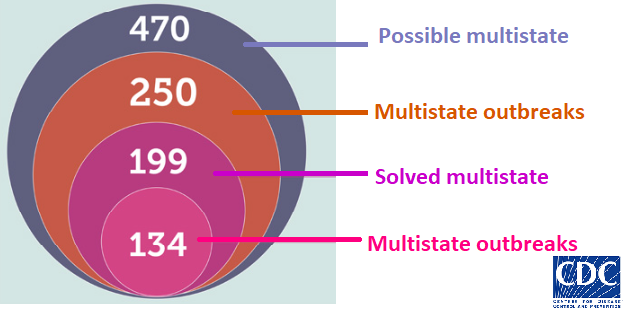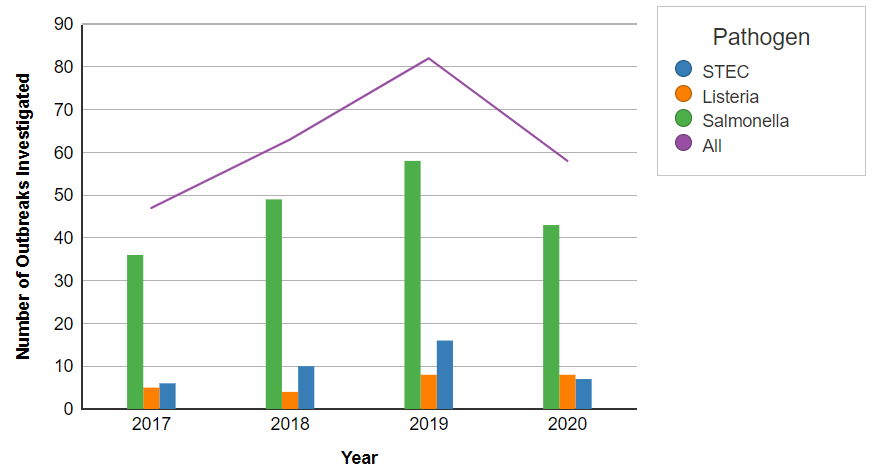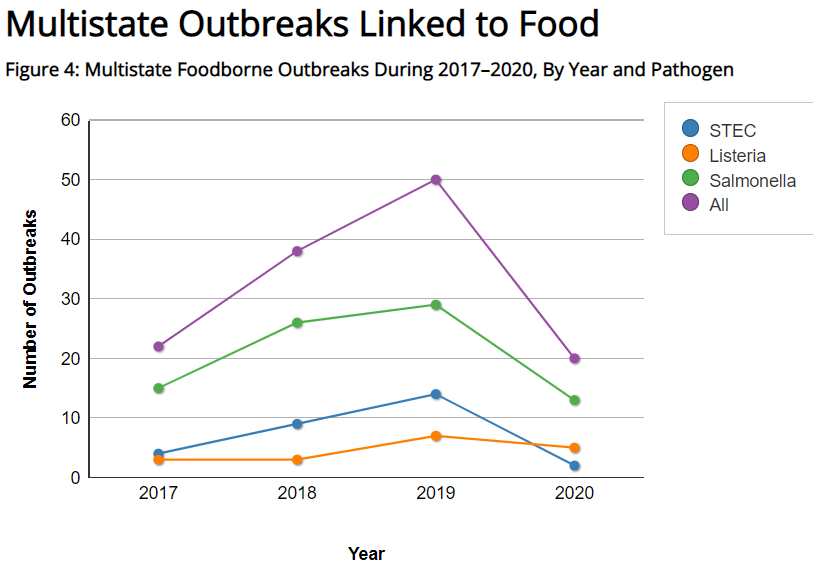CDC’s Investigations of Multistate Outbreaks caused by Salmonella, STEC, and Listeria monocytogenes in 2017-2020
The CDC issued a report on its investigation of multistate outbreaks between 2017-2020 caused by Salmonella, STEC, and Listeria monocytogenes.

Definitions
Possible multistate outbreaks: At least two sick people with similar illnesses in more than two states.
Multistate outbreaks: At least two sick people with similar illnesses with evidence of a common source.
Solved multistate outbreaks: An outbreak with identified source.
Multistate outbreaks- confirmed source: Solved outbreaks with epidemiological data and lab and traceback data.
Analysis
The CDC analyzed the outbreaks of Salmonella, STEC, and Listeria monocytogenes during 2017-2020. The analysis includes 470 possible multistate outbreaks during this period. The investigation showed that 250 (53%) of these were multistate outbreaks, and the investigation solved 199 (80%) of the outbreaks. There was enough information to confirm the source for 134 (67%) outbreaks as solved.

The increase in investigated outbreaks, especially between 2018 and 2019, probably resulted from the implementation of whole genome sequencing in PulseNet. The number of investigated outbreaks fell in 2020, probably due to the COVID-19 pandemic.
The 250 multistate outbreaks investigated included 39 outbreaks of STEC, 25 Listeria monocytogenes, and 186 Salmonella. The 250 investigated multistate outbreaks resulted in 14,312 illnesses, 3,517 hospitalizations, and 65 deaths.
From 2017 through 2020, CDC issued 65 outbreak notices, including 52 linked to contaminated foods and 13 linked to animal contact. Among the 134 multistate outbreaks with a confirmed source, 43 resulted in product recalls or withdrawal of the contaminated product from the market.
Important outbreaks
Salmonella and Ground Beef
Two large outbreaks resulted from ground beef and the same strain of Salmonella. During the first outbreak in 2016-2017, the strain of Salmonella Newport causing illnesses was also found in cattle. In 2018, the same strain caused one of the largest outbreaks of ground beef in decades with 403 cases in 30 states, with 117 hospitalizations. The outbreaks emphasized the need for improved cattle traceability.
STEC O157 and Leafy Greens
The most extensive multistate STEC O157 happened in spring 2018. The outbreak was linked to romaine lettuce from multiple farms in the Yuma, Arizona, growing region. It involved 210 cases, in 36 states, with 96 hospitalizations and five deaths.
Another strain of STEC O157 caused outbreaks in 2018 and 2019 linked to romaine from growing regions on the Central Coast of California. Agriculture water and cattle may have contributed to the outbreak. As a result of the outbreaks, the leafy greens industry began voluntarily labeling prepackaged leafy greens to help identify where they were grown.
Salmonella and Raw Turkey and Chicken Products
During 2017–2019, two multistate Salmonella outbreaks linked to raw poultry products sickened 487 people. Salmonella Infantis was linked to raw chicken products. A raw turkey outbreak was linked to Salmonella Reading. During both investigations, outbreak strains were found in various raw poultry products, raw pet food, and live poultry. No common food product or supplier was identified in either outbreak. The Salmonella Reading outbreak resulted in recalls of ground turkey and raw turkey pet food products.
Salmonella and Pig Ear Pet Treats for Dogs
The outbreak was the first outbreak connected to pig ears pet treats. It involved 154 cases in 34 states with 35 hospitalizations. Multiple strains of Salmonella were detected, many of which were multidrug-resistant (MDR). The outbreak highlighted the risk of illness associated with feeding pets with pig ear treats and possibly other pet treats. No single supplier, distributor, or common brand of pig ear treats was identified.
Salmonella and Contact with Backyard Poultry
In 2020, backyard poultry outbreaks resulted in 1,722 cases in all 50 states, with 333 hospitalizations and one death. 12 Salmonella serotypes caused the outbreaks. There is a need to investigate these outbreaks better.

Outbreaks due to foods
There were 199 solved multistate outbreaks and 130 confirmed or suspected of being linked to contaminated foods. The solved multistate outbreaks were associated with 7,659 illnesses, 2,044 hospitalizations, and 41 deaths.
Listeria infections occurred in adults over 65 years (56%) more frequently than with Salmonella and STEC infections.
Salmonella caused the most multistate outbreaks (64%), followed by STEC (22%), then Listeria (14%). Foodborne outbreaks due to Salmonella tended to be larger (median: 30 illnesses, range: 2–1,132) compared to those caused by STEC (median: 21 illnesses, range: 6–239) and Listeria (median: 7.5 illnesses, range: 2–36). However, illnesses in Listeria outbreaks were more severe. 94% of people were hospitalized, and 16% died, compared to 33% of people hospitalized and 0.3% of people who died in Salmonella outbreaks, 39% of people hospitalized, and 0.65% of people who died in multistate STEC outbreaks.
Fruits were the source of the most solved multistate foodborne outbreaks during 2017–2020. The fruits most linked to outbreaks were papayas (6) and melons (6). Vegetable raw crops, such as leafy green, were the second most common source of multistate foodborne outbreaks. Romaine was the most common leafy green implicated in multistate outbreaks.

Onions were linked to three multistate outbreaks. These outbreaks resulted in the most outbreak-associated illnesses (1,400) of any food category. At least one multistate outbreak linked to beef, chicken, dairy, fruits, and vegetable row crops occurred annually from 2017–2020.
Impact of Foodborne Illnesses
The CDC summary identified 7,659 illnesses, 2,044 hospitalizations, and 41 deaths associated with foodborne outbreaks. Among the foodborne illnesses connected to solved multistate outbreaks, 9% happened in children under five, and 20% occurred among adults over 65, both vulnerable groups. Additionally, a higher proportion of L. monocytogenes infections occurred among adults over 65 years of age compared to Salmonella and STEC infections.
